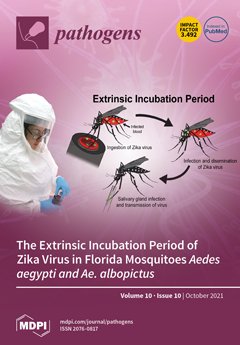Rodents represent a natural reservoir of several
Bartonella species, including zoonotic ones. In this study, small wild rodents, collected from two sites in rural areas of Switzerland, were screened for
Bartonella spp. using molecular detection methods. In brief, 346 rodents were trapped in
[...] Read more.
Rodents represent a natural reservoir of several
Bartonella species, including zoonotic ones. In this study, small wild rodents, collected from two sites in rural areas of Switzerland, were screened for
Bartonella spp. using molecular detection methods. In brief, 346 rodents were trapped in two rural sites in the Gantrisch Nature Park of Switzerland (Plasselb, canton of Fribourg, and Riggisberg, canton of Bern). Pools of DNA originating from three animals were tested through a qPCR screening and an end-point PCR, amplifying the 16S-23S rRNA gene intergenic transcribed spacer region and citrate synthase (
gltA) loci, respectively. Subsequently, DNA was extracted from spleen samples belonging to single animals of
gltA positive pools, and
gltA and RNA polymerase subunit beta (
rpoB) were detected by end-point PCR. Based on PCR results and sequencing, the prevalence of infection with
Bartonella spp. in captured rodents, was 21.10% (73/346): 31.78% in
Apodemus sp. (41/129), 10.47% in
Arvicola scherman (9/86), 17.05% in
Myodes glareolus (22/129), and 50% in
Microtus agrestis (1/2). A significant association was observed between
Bartonella spp. infection and rodent species (
p < 0.01) and between trapping regions and positivity to
Bartonella spp. infection (
p < 0.001). Similarly, prevalence of
Bartonella DNA was higher (
p < 0.001) in rodents trapped in woodland areas (66/257, 25.68%) compared to those captured in open fields (9/89, 10.11%). Sequencing and phylogenetic analysis demonstrated that the extracted
Bartonella DNA belonged mainly to
B. taylorii and also to
Candidatus “Bartonella rudakovii”,
B. grahamii,
B. doshiae, and
B. birtlesii. In conclusion, the present study could rise public health issues regarding
Bartonella infection in rodents in Switzerland.
Full article






